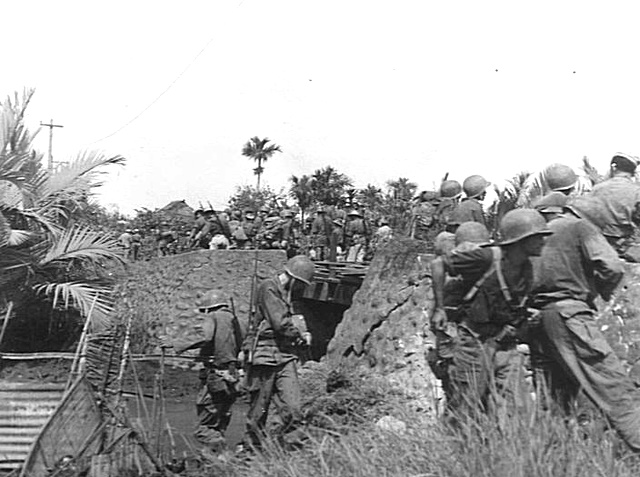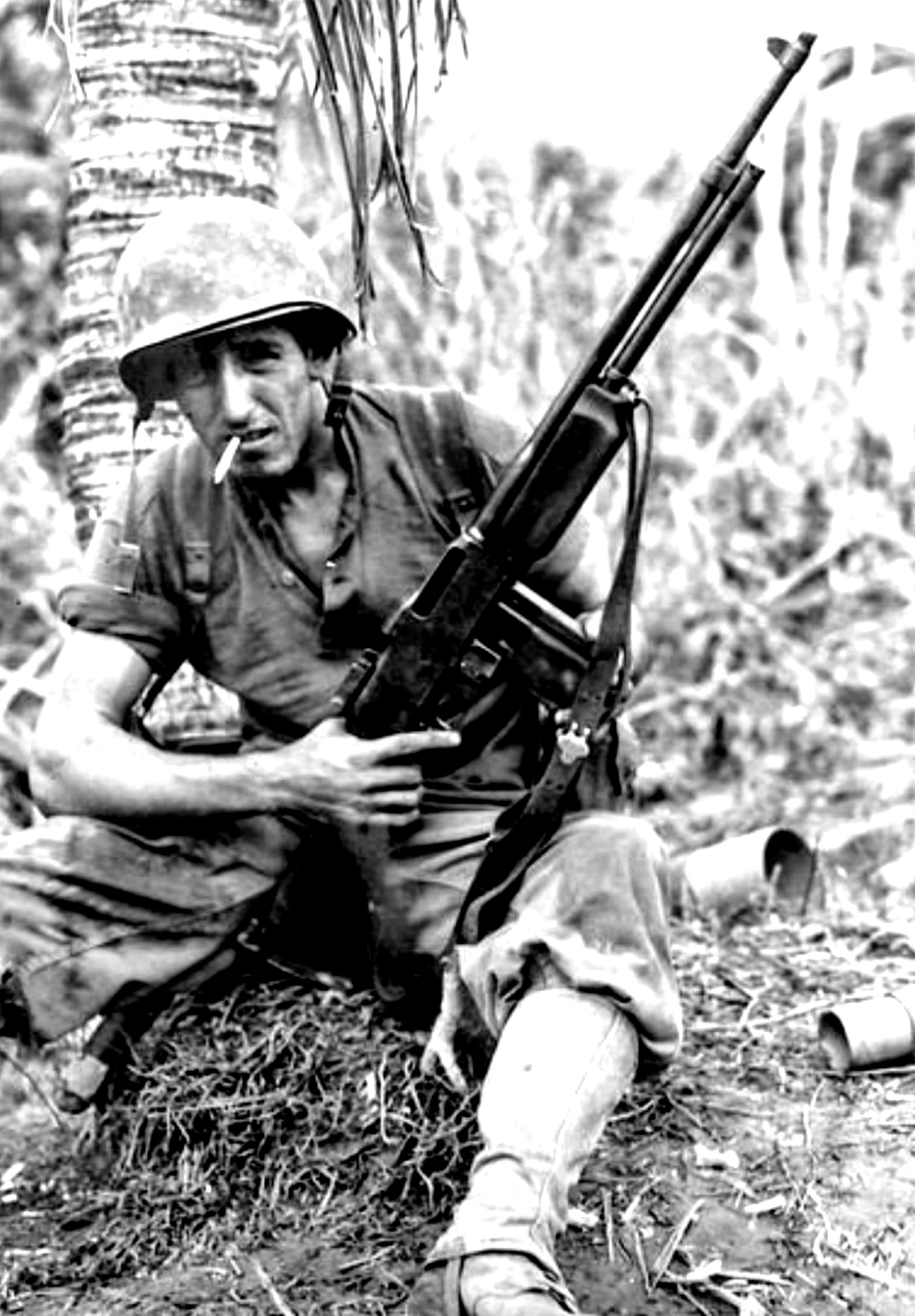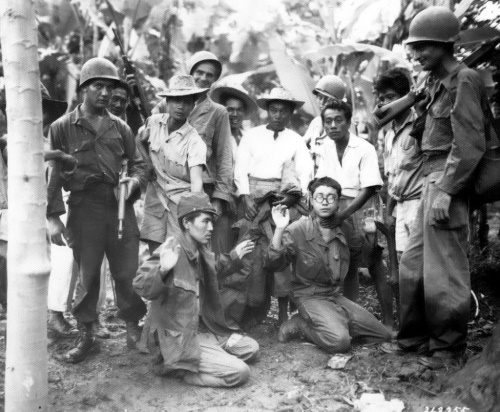Document Source: US Army War Department Order of Battle US Army 1945; Wikipedia; Philippine Scouts Revue
 The 24th Infantry Division traces its lineage to Army units activated in Hawaii. It was activated under the Square Division Table of Organization and Equipment (TO&E) on March 1, 1921 as the Hawaiian Division at Schofield Barracks (Oahu). The division was assigned the 21st Infantry Regiment and the 22nd Infantry Regiment, both of these regiments being assigned to the of which had been assigned to the 11th Infantry Division prior to 1921. The entire Hawaiian Division was concentrated at a single location during the next few years, allowing it to conduct more effective combined arms training. It was also manned at higher personnel levels than other divisions, and its field artillery was the first to be motorized.
The 24th Infantry Division traces its lineage to Army units activated in Hawaii. It was activated under the Square Division Table of Organization and Equipment (TO&E) on March 1, 1921 as the Hawaiian Division at Schofield Barracks (Oahu). The division was assigned the 21st Infantry Regiment and the 22nd Infantry Regiment, both of these regiments being assigned to the of which had been assigned to the 11th Infantry Division prior to 1921. The entire Hawaiian Division was concentrated at a single location during the next few years, allowing it to conduct more effective combined arms training. It was also manned at higher personnel levels than other divisions, and its field artillery was the first to be motorized.
Between August and September 1941, the Hawaiian Division’s assets were reorganized to form two divisions under the new Triangular Division TO&E. Its brigade headquarters were disbanded and the 27th Infantry Regiment and the 35th Infantry Regiment were assigned to the new 25th Infantry Division. The 24th Infantry Division also received the Hawaiian Division’s Shoulder Sleeve Insignia (division insignia based on the taro leaf, emblematic of Hawaii) which was approved in 1921. The Hawaiian Division headquarters was re-designated as Headquarters, 24th Infantry Division on October 1, 1941. The 24-ID was then centered around three infantry regiments: the 19th Infantry Regiment and the 21st Infantry Regiment from the old Hawaiian Division, and the 299th Infantry Regiment from the Hawaii National Guard. In July 1942, the 299th Infantry was inactivated after its ranks were depleted by the transfer of many Nisei (second-generation of Japanese-Americans) to form the 100th Infantry Battalion, and the 25th Infantry Division’s 298th Infantry Regiment was reassigned to the 24-ID. Also part of the division were the 13th Field Artillery Battalion, the 52nd Field Artillery Battalion, the 63rd Field Artillery Battalion, the 11th Field Artillery Battalion, the 24th Signal Company, the 724th Ordnance Light Maintenance Company, the 24th Quartermaster Company, the 24th Reconnaissance Troop, the 3rd Engineer Combat Battalion, the 24th Medical Battalion, and the 24th Counterintelligence Corps Detachment.
The 24th Infantry Division moved to Australia on August 8, 1943; arrived on Goodenough Island on February 15, 1944, and assaulted Tanahmerah Bay (New Guinea), on April 22, 1944; assaulted Leyte (Philippines), on October 20, 1944, and landed on Mindoro on January 29, 1945. The 24th Infantry Division arrived in Mindanao on April 17, 1945, departed the Philippines on October 15, 1945 and arrived in Japan on October 22, 1945, where the division was active thru 1946.
Campaigns:
Central Pacific
New Guinea
Leyte
Southern Philippines
Luzon
Killed in action, 1374
Wounded in action, 5621
Missing in action, 11
Prisoners of war, 6
Total battle casualties, 7012
Order of Battle (1941)
19th Infantry Regiment
21st Infantry Regiment
299th Infantry Regiment (Deac. Jul 21, 1942)
HHB Division Artillery
11th Field Artillery Battalion (155-MM)
13th Field Artillery Battalion (105-MM)
52nd Field Artillery Battalion (105-MM)
63rd Field Artillery Battalion (105-MM)
Headquarters, 24th Infantry Division
Headquarters & Military Police Company
3rd Engineer Combat Battalion
24th Medical Battalion
24th Quartermaster Battalion
24th Reconnaissance Troop
24th Signal Company
Order of Battle (1944-1945)
19th Infantry Regiment
21st infantry Regiment
34th Infantry Regiment
Note: The 34-IR assigned on Jun 12, 1943, was replaced by the 298-IR which had been assigned to the division from Jul 23, 1942 to Jun 12, 1943 and attached Jun 12-16 1943)
HHB Division Artillery
11th Field Artillery Battalion (155-MM)
13th Field Artillery Battalion (105-MM)
52nd Field Artillery Battalion [105-MM)
63rd Field Artillery Battalion (105-MM)
24th Reconnaissance Troop, Mez
3rd Engineer Combat Battalion
24th Medical Battalion
24th Counter Intelligence Corps Det
Headquarters Special Troops
Headquarters Co, 24th Infantry Division
Headquarters & Military Police Company
724th Ordnance Light Maintenance Co
24th Quartermaster Battalion
24th Signal Company
Commanding Generals
Maj Gen Durward S. Wilson, October 1941 – July 1942
Maj Gen Frederick A. Irving, August 1942 – October 1944
Maj Gen Roscoe B. Woodruff, November 1944 – November 1945
Brig Gen Kenneth F. Cramer, November 1945 – December 1945
Maj Gen James A. Lester, December 1945 – VEDay
Assistant Division Commander
Brig Gen Kenneth F. Cramer – October 1941 – November 1945
Narrative

 The division was stationed at Schofield Barracks (Oahu) (Hawaii – Pearl Harbor) when the Japanese planes attacked it on December 7, 1941, and directed as a result to build an elaborate system of coastal defenses on Northern Oahu. In May 1943, it was alerted to Australia and completed movement thereby echelon on September 8, 1943, training at Camp Caves (Rockhampton). It staged and rehearsed at Goodenough Island on February 15, 1944, after which the 19-IR and the 21-IR Inf landed at Tanahmerah Bay, New Guinea, on April 22, 1944, and the 34-IR went ashore at Humboldt Bay. Despite torrential rains and marshy terrain, the 21-IR overran the Hollandia Airdrome and linked up with the 41-ID on April 26, 1944. The division engaged in extensive patrolling of its area until June 6, 1944. On June 15, the 34-IR was detached to Biak Island where it seized both Boroke Airdrome and the Sorido Airdrome on June 20 and then mopped up, rejoining the division on July 17.
The division was stationed at Schofield Barracks (Oahu) (Hawaii – Pearl Harbor) when the Japanese planes attacked it on December 7, 1941, and directed as a result to build an elaborate system of coastal defenses on Northern Oahu. In May 1943, it was alerted to Australia and completed movement thereby echelon on September 8, 1943, training at Camp Caves (Rockhampton). It staged and rehearsed at Goodenough Island on February 15, 1944, after which the 19-IR and the 21-IR Inf landed at Tanahmerah Bay, New Guinea, on April 22, 1944, and the 34-IR went ashore at Humboldt Bay. Despite torrential rains and marshy terrain, the 21-IR overran the Hollandia Airdrome and linked up with the 41-ID on April 26, 1944. The division engaged in extensive patrolling of its area until June 6, 1944. On June 15, the 34-IR was detached to Biak Island where it seized both Boroke Airdrome and the Sorido Airdrome on June 20 and then mopped up, rejoining the division on July 17.
After occupation duty at Hollandia (New Guinea), the division assaulted Leyte (Philippines) on October 20, the 21-IR landing in the Panaon Straight area and the rest of the division assaulting the Palo-Pawing Area, seizing key Hill 522 in heavy combat. The 34-IR was subjected to a fierce Japanese counter-attack on October 21, while the 19-IR took Palo and underwent counter-attacks.

 The 34-IR, supported by naval gunfire and air support, secured its Pawing Area and both regiments pushed into the Leyte Valley (October 26) where they linked up with the US 1-CD converging on Carigara near the Northern Entrance of the Ormoc Valley on November 2. The 21-IR relieved the 34-IR at Breakneck Ridge west of Pinamopoan, November 5, and assaulted it despite a raging typhoon, gaining its crest finally on November 12.
The 34-IR, supported by naval gunfire and air support, secured its Pawing Area and both regiments pushed into the Leyte Valley (October 26) where they linked up with the US 1-CD converging on Carigara near the Northern Entrance of the Ormoc Valley on November 2. The 21-IR relieved the 34-IR at Breakneck Ridge west of Pinamopoan, November 5, and assaulted it despite a raging typhoon, gaining its crest finally on November 12.
 The 32-ID relieved the division on November 17, and it moved to Jaro and Cavite, attaching the 19-IR to the US 6-A on November 20, for operations on Mindoro as the major unit of the Western Visayan Task Force. The 34-IR battled for Kilray Ridge until December 2 under the 32-ID and then moved to Calubian and over water to beach defense at Pinamopoan with the division. The 19-IR invaded Mindoro (December 15) between Caminawit Point and San Agustin, being joined by the 21-IR which became part of the Western Visayan Task Force also on December 30, 1944. The division sent its remaining 34-IR to clear the northwest part of Leyte, and landed at Taglawigan on December 27, to accomplish its mission.
The 32-ID relieved the division on November 17, and it moved to Jaro and Cavite, attaching the 19-IR to the US 6-A on November 20, for operations on Mindoro as the major unit of the Western Visayan Task Force. The 34-IR battled for Kilray Ridge until December 2 under the 32-ID and then moved to Calubian and over water to beach defense at Pinamopoan with the division. The 19-IR invaded Mindoro (December 15) between Caminawit Point and San Agustin, being joined by the 21-IR which became part of the Western Visayan Task Force also on December 30, 1944. The division sent its remaining 34-IR to clear the northwest part of Leyte, and landed at Taglawigan on December 27, to accomplish its mission.
 On January 3, 1945, the 21-IR landed on Marinduque Island and then returned to Mindoro, where the division arrived entirely on January 29. The 34-IR landed at San Antonio and suffered heavy losses at the Battle of Zig Zag Pass. The 19-IR was sent to Luzon (February 10) and attached to the 11th Airborne Division to assist its drive from Nasugbu to Manila. The 19-IR sent a battalion against Corregidor Island, on February 16, to assist the paratroopers in air-assaulting the fortress. The division meanwhile landed the 19-IR on Verde Island (February 23) and cleared several adjacent islands by March 25, which included Lubang, Ambil, Cabra, Golo, Romblon, and Simara; the 34-IR joining these operations (February 28) and the 19-IR joining the offensive on March 7, 1945.
On January 3, 1945, the 21-IR landed on Marinduque Island and then returned to Mindoro, where the division arrived entirely on January 29. The 34-IR landed at San Antonio and suffered heavy losses at the Battle of Zig Zag Pass. The 19-IR was sent to Luzon (February 10) and attached to the 11th Airborne Division to assist its drive from Nasugbu to Manila. The 19-IR sent a battalion against Corregidor Island, on February 16, to assist the paratroopers in air-assaulting the fortress. The division meanwhile landed the 19-IR on Verde Island (February 23) and cleared several adjacent islands by March 25, which included Lubang, Ambil, Cabra, Golo, Romblon, and Simara; the 34-IR joining these operations (February 28) and the 19-IR joining the offensive on March 7, 1945.
The division landed the 21-IR at Baras and the 19-IR at Parang on Mindanao on April 17. Filipino forces were already in possession of Malabang, and the division drove overland along Highway 1 with the 19-IR as the 21-IR made amphibious drives up two branches of the Mindanao River. On April 19, the 34-IR in reserve was landed at Parang to reinforce, and moved by water to occupy undefended Fort Pikit and seized the junction of Highway 1 and the Sayre Highway the following day. On April 24, the 34-IR led the division push onto Digos on Davao Gulf. Despite demolitions and delaying obstacles the 19-IR bypassed and contained Hill 550 commanding the Davao approaches on May 1, and stormed the city on May 3. The 34-IR reduced a Japanese pocket in the Guma Sector and the 21-IR, supported by mass artillery fires, attacked along the Talamo River on May 12. The 19-IR and the 34-IR tackled Hill 550, which fell to the latter after a battle of several days on May 21, 1945. As the division continued to clear the Talamo River Vallev the 19-IR captured Mandog on June 9. The end of organized Japanese resistance on Mindanao was declared on June 30, but the division continued operations in the Kibangay Area. The 21-IR landed at Sarangani Bay and secured the area on July 12, 1945. The division continued mopping up, patrolling, and performing security on Mindanao until the end of the war.






















